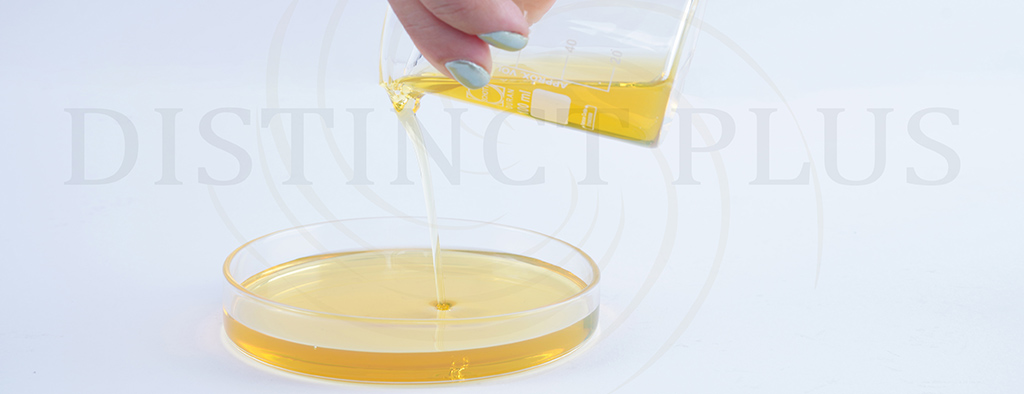Base oil is a key ingredient used in the production of various products, including lubricating greases, motor oil, and metal processing fluids. Different products require specific compositions and characteristics of oil, with viscosity at different temperatures being a crucial factor.
Base oil is derived from the refining of crude oil. During the refining process, crude oil is heated to separate different distillates. The heating process separates light and heavy hydrocarbons. Lighter hydrocarbons can be refined into gasoline and other fuels, while heavier ones are suitable for bitumen and base oils.
Various types of crude oil from around the world are used in the production of base oil. The most commonly used is paraffinic crude oil, although naphthenic crude oils are also utilized, resulting in products with excellent solubility and low-temperature performance. Hydrogenation technology, which involves the removal of sulfur and aromatics using high-pressure hydrogen, can produce exceptionally pure base oils to meet stringent quality requirements.
To meet the quality requirements of the end product, additives, which are chemical substances, are introduced to the base oil. These additives enhance properties such as friction and cleaning. Some types of motor oil contain over twenty percent additives.
Uses of Base Oil
Base oil finds applications in the following areas:
- Gasoline and diesel engine oils
- Bi-fuel and gas engine oils
- Industrial lubricants
- Grease and specialty products
- Varieties of Base Oil
Base oil types
Mineral Base Oil:
Mineral base oil is obtained through the refining of crude oil. Approximately 1 to 2% of crude oil barrels are refined to produce base oil. The remaining portion is used in the production of gasoline, diesel, kerosene, coke, bitumen, and other hydrocarbons.
Synthetic Base Oil:
Synthetic base oil is created through chemical synthesis. Based on the molecular structure, it can be classified into paraffinic base oil and naphthenic base oil. It consists of hydrocarbons with 18 to 40 carbon atoms. Naphthenic base oils exhibit superior solubility and low-temperature performance compared to other types. Lubricating oil typically contains 1% to 20% specific additives mixed with base oil.
The purest form of base oil is obtained through the hydrogenation process, which involves the removal of sulfur and aromatics under high-pressure hydrogen application.
Base oil is categorized into five main groups based on viscosity, saturates, sulfur content, and other factors. These categories provide insights into the composition, manufacturing process, and performance of the oil under conditions such as extreme heat.
The American Petroleum Institute (API) has classified base oils into five categories. The first three groups are refined from crude petroleum oil.
Group I
Group I base oils belong to a category with less than 90 percent saturates, over 0.03 percent sulfur, and a viscosity index ranging from 80 to 120. Operating within a temperature range of 32 to 150 degrees Fahrenheit, these oils undergo solvent refining, which is a simpler process. As a result, they are the most cost-effective base oils available in the market.
Group II
Characterized by over 90 percent saturates, less than 0.03 percent sulfur, and a viscosity index between 80 and 120, Group II base oils are typically produced through a more complex method called hydrocracking. Due to the saturation of all hydrocarbon molecules, these oils exhibit excellent antioxidation properties. They also have a lighter color but come at a higher price compared to Group I oils. However, Group II base oils are increasingly prevalent and competitively priced, approaching the cost of Group I oils.
Group III
Group III base oils contain more than 90 percent saturates, less than 0.03 percent sulfur and have a viscosity index exceeding 120. They undergo an even more extensive refining process than Group II oils, often involving severe hydrocracking under high pressure and temperature. This thorough process aims to produce a purer base oil. Although derived from crude oil, Group III base oils are sometimes referred to as synthesized hydrocarbons. Similar to Group II base oils, these oils are gaining prominence in the market.
Group IV
Group IV base oils, also known as polyalphaolefins (PAOs), are synthetic oils produced through synthesis. They exhibit a wide temperature range, making them suitable for use under extreme cold and high heat conditions.
Group V
Group V includes all other base oils not covered in the previous groups, such as silicone, phosphate ester, polyalkylene glycol (PAG), polyolester, biolubes, and more. These oils are sometimes blended with other base stocks to enhance their properties. For example, a PAO-based compressor oil may be mixed with a polyolester. Ester oils, a common type of Group V base oils, are used in various lubricant formulations to improve the properties of the base oil. They offer superior detergency and can withstand higher temperatures, allowing for extended usage hours compared to PAO synthetic base oils.
Base Oil Grades and Specifications
Various grades of base oil are available in the market, including SN 150, SN 300, SN 500, and SN 650. The abbreviation “SN” stands for Solvent Neutral base oil, while the succeeding numbers represent the SUS Viscosity at 40 degrees Celsius. SN 150, SN 300, and SN 500 have a light color, while the rest have a dark color. In general, a higher viscosity index corresponds to a darker color.
Desirable Characteristics
• Optimal heat and oxidative stability
• Consistent viscosity
• Stable operational properties
• Low volatility
• Suitable Viscosity Index (VI)
• Light color
• High flash point
• Low Total Acid Number (TAN)
• Low sulfur content
Packaging Options
• Drum
• Flexitank
• Intermediate Bulk Container (IBC) Tank
Storage Recommendations
• The ideal storage for lubricants is indoors. If indoor storage is not available, an outdoor covered location protected from sunlight, rain, and snow can help extend the lifespan of the lubricant.
• Preventing temperature fluctuations and maintaining a storage temperature of around 25 degrees Celsius can significantly contribute to preserving lubricant quality.
• Under normal conditions, this product is stable, non-corrosive, and can be stored in mild steel containers.
Safety, Health, and Environmental Considerations
• Under normal circumstances, this product is stable and poses minimal risks of irritation to the skin and eyes.
• Limit prolonged and repeated skin exposure to used oil.
• In case of skin contact, cleanse with soap and water.
• Avoid environmental pollution. Dispose of used oil at designated collection sites.


